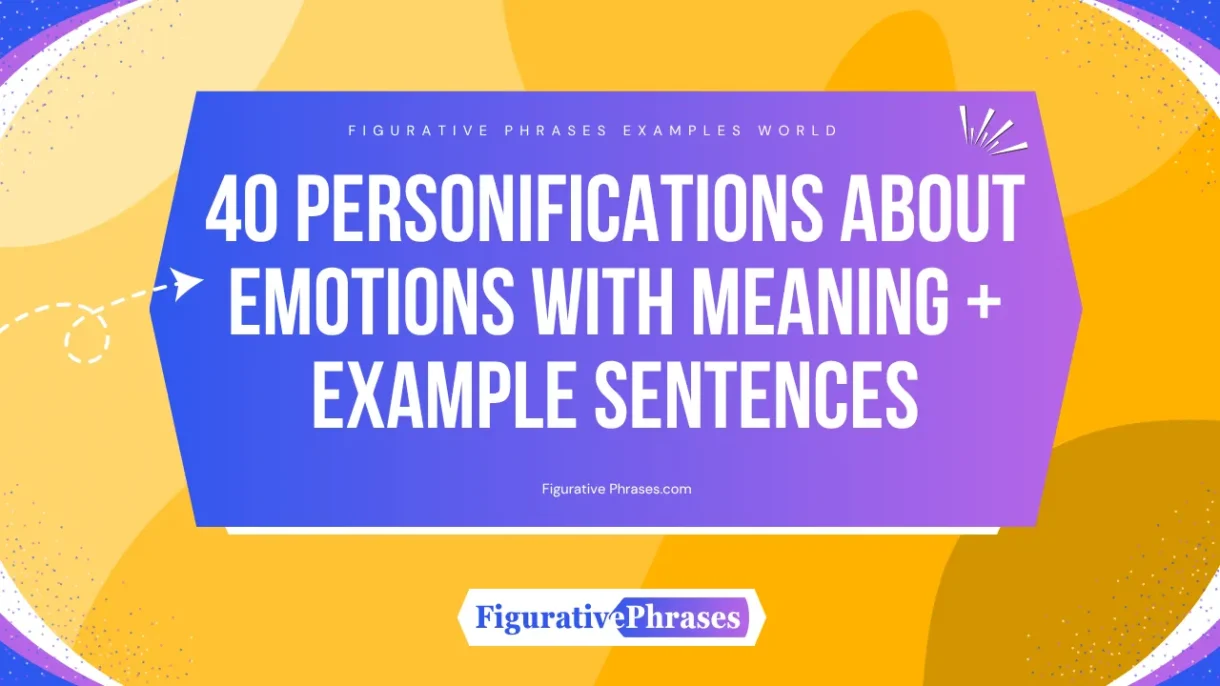
I wrote this guide to make feelings act like people so they move and do things on the page. In each section, I share five fresh personifications with a simple meaning, when to use them, and a short example. I start with emotions in general, then I go through happiness, sadness, love, hate, anger, calm, excitement, and boredom, and I add a few more common feelings. I also include a short part where I let the brain and body “speak” in easy lines to show how feelings work inside us. I keep the words plain so you can grab the right line fast and keep your writing clear. As you read, the last line of each section gently points you to the next feeling, so the whole piece flows.
What are the Personifications about emotions with examples?
Emotions act like people in these lines—they knock, nudge, and steer. Use them when you want a feeling to do something on the page, not just sit as a label.
Emotion knocks on my ribs
- Meaning: a sudden, physical-feeling arrival of feeling
- When to use: to show a quick, noticeable start of any emotion
- Example: Emotion knocked on my ribs, and I finally listened.
- Other ways to say: feeling taps my chest, feeling raps the door inside, feeling rings my bell
Emotion pulls the room into focus
- Meaning: feeling makes details sharp and important
- When to use: when a mood heightens attention
- Example: Emotion pulled the room into focus; the clock got loud.
- Other ways to say: feeling tightens the lens, feeling clears the glass, feeling sharpens the frame
Emotion takes the driver’s seat
- Meaning: feeling controls choices
- When to use: to show impulse or guided action by mood
- Example: Emotion took the driver’s seat, and I turned left without thinking.
- Other ways to say: feeling grabs the wheel, feeling charts the route, feeling steers my steps
Emotion stitches words to my tongue
- Meaning: feeling shapes speech
- When to use: when mood affects how someone talks
- Example: Emotion stitched words to my tongue, and they came out rough.

- Other ways to say: feeling threads my speech, feeling laces my voice, feeling sews my answer
Emotion sets a chair at the table
- Meaning: feeling becomes part of the scene and cannot be ignored
- When to use: to show a mood joining daily life
- Example: Emotion set a chair at the table and ate with us.
- Other ways to say: feeling takes a seat, feeling joins the meal, feeling sits among us
This makes room for Happiness, which often sits first.
What are the Personifications about Happiness With Examples?
Happiness behaves like a bright guest—opening, lifting, and sharing. Use these happy personifications to show light, ease, and welcome action.
Happiness pulls the curtains wide
- Meaning: joy lets light in
- When to use: when relief or good news arrives
- Example: Happiness pulled the curtains wide and the room woke up.
- Other ways to say: joy opens the blinds, cheer parts the drapes, delight lifts the shades
Happiness pockets small suns
- Meaning: joy keeps tiny bright moments
- When to use: for quiet, kept joy
- Example: Happiness pocketed small suns from an ordinary day.
- Other ways to say: joy saves light, cheer stores sparks, gladness keeps glow
Happiness braids sunlight into my hair
- Meaning: joy makes even the body feel bright
- When to use: for warm, gentle scenes
- Example: Happiness braided sunlight into my hair on the walk home.
- Other ways to say: joy threads gold, cheer weaves shine, delight ties light
Happiness teaches my shoes to skip
- Meaning: joy changes movement
- When to use: to animate action after good news
- Example: Happiness taught my shoes to skip down the steps.
- Other ways to say: joy trains my feet, cheer lifts my stride, delight lightens my step
Happiness passes plates around
- Meaning: joy is shared, not hoarded
- When to use: when joy spreads in a group
- Example: Happiness passed plates around until everyone tasted it.
- Other ways to say: joy serves seconds, cheer shares slices, gladness ladles plenty
Shared plates can feel empty when Sadness walks in.
What are the Personifications about Sadness With Examples?
Sadness acts like a slow worker—weighting, dimming, and closing. Use these sad personifications to show heaviness that changes simple things.
Sadness stitches rain to my sleeves
- Meaning: sorrow clings and stays wet
- When to use: for long, soaking gloom
- Example: Sadness stitched rain to my sleeves all afternoon.
- Other ways to say: sorrow hems drizzle, gloom pins damp, grief tacks mist
Sadness turns the dimmer down
- Meaning: sorrow lowers brightness and hope
- When to use: to soften color or mood in a scene
- Example: Sadness turned the dimmer down on the kitchen light.
- Other ways to say: sorrow fades the bulb, gloom dulls the lamp, grief blurs the glow
Sadness pockets my keys
- Meaning: sorrow delays action and plans
- When to use: when grief makes daily tasks hard
- Example: Sadness pocketed my keys; I missed the bus again.
- Other ways to say: sorrow hides the map, gloom steals minutes, grief misplaces steps
Sadness glues my voice to silence
- Meaning: sorrow stops speech
- When to use: for choked or wordless scenes
- Example: Sadness glued my voice to silence in the waiting room.
- Other ways to say: sorrow locks my mouth, gloom seals my lips, grief knots my throat
Sadness lays a coat on every chair
- Meaning: sorrow covers the whole place
- When to use: to show a house or group under a mood
- Example: Sadness laid a coat on every chair before dinner.
- Other ways to say: sorrow drapes the room, gloom spreads cloth, grief blankets seats
Under those coats, Love sometimes sits close.
What are the Personifications about Love With Examples?
Love behaves like a careful maker—writing, tending, and returning. Use these to show steady care and deep pull.
Love writes its name on my pulse
- Meaning: love marks the body’s rhythm
- When to use: to show bodily truth of care
- Example: Love wrote its name on my pulse when you spoke.
- Other ways to say: love signs my heartbeat, care inks my wrist, affection stamps my vein
Love waters the small plants
- Meaning: love keeps little things alive
- When to use: for daily, patient acts
- Example: Love watered the small plants of our home.
- Other ways to say: love tends sprouts, care feeds roots, affection mists leaves
Love keeps the porch light on
- Meaning: love waits and welcomes
- When to use: for loyalty across distance
- Example: Love kept the porch light on through the storm.
- Other ways to say: love leaves a lamp, care guards the door, devotion holds the glow
Love patches the torn pocket
- Meaning: love repairs what life wears down
- When to use: after conflict or loss
- Example: Love patched the torn pocket where hope slipped out.
- Other ways to say: love mends seams, care darns threads, devotion fixes tears
Love sets two chairs facing the window
- Meaning: love plans shared looking and time
- When to use: when love wants future moments
- Example: Love set two chairs facing the window and waited for morning.
- Other ways to say: love arranges seats, care places space, devotion saves a view
But sometimes a shadow sits between them: Hate.
What are the Personifications about Hate With Examples?
Hate behaves like a harsh worker—sharpening, closing, and burning. Use these to show cutting distance or spite.
Hate sharpens the room’s corners
- Meaning: hate makes space feel hostile
- When to use: to show tension in a shared place
- Example: Hate sharpened the room’s corners during the meeting.
- Other ways to say: spite hardens edges, rancor points walls, loathing files angles
Hate salts the soil of patience
- Meaning: hate kills the ground where calm could grow
- When to use: when someone refuses peace
- Example: Hate salted the soil of patience till nothing sprouted.
- Other ways to say: spite poisons ground, malice burns fields, rancor blights earth
Hate bolts the gate on mercy
- Meaning: hate blocks forgiveness
- When to use: after a hard break or feud
- Example: Hate bolted the gate on mercy and threw the key.
- Other ways to say: spite locks grace, malice bars pardon, rancor seals door
Hate trains my tongue for knives
- Meaning: hate turns words into weapons
- When to use: to show cruel speech
- Example: Hate trained my tongue for knives I later regret.
- Other ways to say: spite sharpens talk, malice tempers words, rancor arms replies
Hate blows out the common candle
- Meaning: hate ends shared light
- When to use: when a group loses unity
- Example: Hate blew out the common candle we met around.
- Other ways to say: spite snuffs lamp, malice kills flame, rancor douses light
When the flame dies, Anger often flares next.
What are the Personifications about Anger With Examples?
Anger acts like a sudden striker—kicking, slamming, and rattling. Use these to show heat that moves fast.
Anger kicks the chair of silence
- Meaning: anger breaks quiet
- When to use: to start a loud moment
- Example: Anger kicked the chair of silence across the floor.
- Other ways to say: rage topples hush, fury jars calm, ire boots stillness
Anger hammers on my ribs
- Meaning: anger pounds inside the body
- When to use: for a hot, physical surge
- Example: Anger hammered on my ribs like a bad drum.
- Other ways to say: rage thumps chest, fury pounds cage, ire beats walls
Anger slams the door on reason
- Meaning: anger blocks clear thought
- When to use: in arguments and snap choices
- Example: Anger slammed the door on reason mid-sentence.
- Other ways to say: rage shuts logic, fury locks sense, ire bars judgment
Anger lights matches in my mouth
- Meaning: anger makes words burn
- When to use: before a harsh reply
- Example: Anger lit matches in my mouth I should not strike.
- Other ways to say: rage sparks speech, fury heats phrases, ire flames talk
Anger rattles the cage then walks away
- Meaning: anger stirs trouble and leaves
- When to use: to show useless flare-ups
- Example: Anger rattled the cage then walked away, and I cleaned the mess.
- Other ways to say: rage shakes bars, fury stirs dust, ire stokes noise
After the noise, some reach for Calm.
What are the Personifications about Calm With Examples?
Calm behaves like a gentle keeper—smoothing, holding, and clearing. Use these to show soft control after storm.
Calm smooths the water in my chest
- Meaning: calm settles breath and heart
- When to use: after worry or anger
- Example: Calm smoothed the water in my chest till it held the sky.
- Other ways to say: peace levels waves, ease stills tide, quiet lays the lake
Calm folds the noise into napkins
- Meaning: calm tidies chaos
- When to use: when order returns
- Example: Calm folded the noise into napkins and stacked them away.
- Other ways to say: peace packs clatter, ease tucks sound, quiet wraps racket
Calm oilings the hinges of talk
- Meaning: calm makes speech flow
- When to use: to restart kind dialogue
- Example: Calm oiled the hinges of talk so we could open the hard part.
- Other ways to say: peace greases words, ease loosens tongues, quiet frees speech
Calm holds the ladder steady
- Meaning: calm supports careful work
- When to use: during a delicate task
- Example: Calm held the ladder steady while I reached for the truth.
- Other ways to say: peace braces steps, ease steadies rungs, quiet keeps balance
Calm sweeps a path through the crowd
- Meaning: calm creates space to move
- When to use: to choose a mindful way
- Example: Calm swept a path through the crowd, and I followed.
- Other ways to say: peace parts traffic, ease clears lane, quiet opens way
That open path can lead toward feeling Excited without chaos.
What are the Personifications about Excited With Examples?
Excited acts like a lively drummer—beating, bouncing, and buzzing. Use these to show quick, bright motion.
Excitement drums on my bones
- Meaning: thrill is felt in the body
- When to use: before an event or news
- Example: Excitement drummed on my bones before the curtain rose.
- Other ways to say: thrill taps my ribs, buzz beats my frame, zest pats the cage
Excitement teaches the stairs to two-step
- Meaning: thrill speeds movement
- When to use: running out the door moments
- Example: Excitement taught the stairs to two-step under my feet.
- Other ways to say: thrill quickens steps, buzz springs stairs, zest bounces treads
Excitement pastes stars on the ceiling
- Meaning: thrill makes the room feel magical
- When to use: night-before anticipation
- Example: Excitement pasted stars on the ceiling I could not sleep under.
- Other ways to say: thrill pins constellations, buzz tapes sparks, zest sticks lights
Excitement winds the toy again
- Meaning: thrill renews energy
- When to use: second wind scenes
- Example: Excitement wound the toy again when I almost quit.
- Other ways to say: thrill rewinds spring, buzz reloads coil, zest cranks gears
Excitement presses send for me
- Meaning: thrill pushes action past doubt
- When to use: to show brave click or leap
- Example: Excitement pressed send for me before fear answered.
- Other ways to say: thrill hits go, buzz fires launch, zest taps submit
When the rush fades, Bordem can creep in if nothing new arrives.
What are the Personifications about Bordem With Examples?
Boredom acts like a slow guard—stalling, stretching, and dulling. Use these to show stale time and flat color.
Boredom holds the clock’s hand
- Meaning: time feels stuck
- When to use: long waits and slow tasks
- Example: Boredom held the clock’s hand for an extra hour.
- Other ways to say: tedium pins minutes, dullness grips ticks, monotony freezes time
Boredom paints the day in primer
- Meaning: nothing has final color
- When to use: same-old routines
- Example: Boredom painted the day in primer and left.
- Other ways to say: tedium leaves gray, dullness flattens hue, monotony washes tone
Boredom lays bricks on my eyelids
- Meaning: heavy sleepiness from sameness
- When to use: during lectures or queues
- Example: Boredom laid bricks on my eyelids by slide ten.
- Other ways to say: tedium weights lids, dullness stacks stones, monotony sands focus
Boredom files the edges off wonder
- Meaning: nothing feels surprising
- When to use: when novelty dies
- Example: Boredom filed the edges off wonder till it was smooth and plain.
- Other ways to say: tedium blunts awe, dullness rounds magic, monotony dulls spark
Boredom irons the map flat
- Meaning: all paths look the same
- When to use: choice without interest
- Example: Boredom ironed the map flat, so every road yawned alike.
- Other ways to say: tedium presses routes, dullness flattens turns, monotony levels paths
Other emotions can still speak under this flat sheet—see other personifications below.
What are other Personifications about emotions With Examples?
These cover more feelings that visit often. Use them to round out scenes with quick, precise motion.
Fear locks the windows and checks them twice
- Meaning: fear restricts and repeats
- When to use: cautious, hyper-vigilant moments
- Example: Fear locked the windows and checked them twice before bed.
- Other ways to say: fear bolts latches, dread tests seals, worry patrols frames
Guilt drags its chain across the floor
- Meaning: guilt follows with noise
- When to use: after a mistake
- Example: Guilt dragged its chain across the floor of my thoughts.
- Other ways to say: remorse trails links, regret scrapes metal, shame hauls weight
Pride polishes its badge in public
- Meaning: pride shows off
- When to use: boastful display scenes
- Example: Pride polished its badge in public during the toast.
- Other ways to say: pride buffs medal, vanity shines crest, ego gleams mark
Jealousy counts my neighbor’s smiles
- Meaning: envy measures others’ joy
- When to use: compare-and-ache moments
- Example: Jealousy counted my neighbor’s smiles like coins.
- Other ways to say: envy tallies laughs, covetousness totals cheers, green-eye adds grins
Hope lifts a porch bell and rings softly
- Meaning: hope asks to be let in
- When to use: fragile but steady optimism
- Example: Hope lifted the porch bell and rang softly before dawn.
- Other ways to say: hope taps chime, optimism knocks light, expectancy hums tune
Psychology can name what’s happening under these acts.
What are The emotions Personifications in Psychology With Examples?
These personifications examples give feelings human moves while nodding to brain and body. Use them to link poetry with simple science.
The amygdala raises its hand first
- Meaning: threat system speaks before reason
- When to use: jumpy startle or hot take
- Example: The amygdala raised its hand first, and calm called on it later.
- Other ways to say: alarm center interrupts, guard shouts first, sentinel signals early
Dopamine rings the doorbell of want
- Meaning: reward call invites action
- When to use: cravings, goals, curiosity
- Example: Dopamine rang the doorbell of want when the idea clicked.
- Other ways to say: reward knocks, drive calls, incentive buzzes
Cortisol stomps in with muddy boots
- Meaning: stress barges in and messes things
- When to use: deadlines, fear, overload
- Example: Cortisol stomped in with muddy boots and tracked up the day.
- Other ways to say: stress barges, pressure tramps, strain tromps
Serotonin straightens the picture frames
- Meaning: mood balance tidies the scene
- When to use: steady contentment and order
- Example: Serotonin straightened the picture frames after the storm inside.
- Other ways to say: balance aligns frames, steadiness sets level, well-being squares edges
The prefrontal coach calls a timeout
- Meaning: thinking brain pauses action
- When to use: reappraisal, choosing a wiser move
- Example: The prefrontal coach called a timeout before my mouth ran on.
- Other ways to say: reasoning halts play, planner signals pause, guide lifts the whistle
With names and moves together, your emotion scenes read clear and alive.






0 Comments